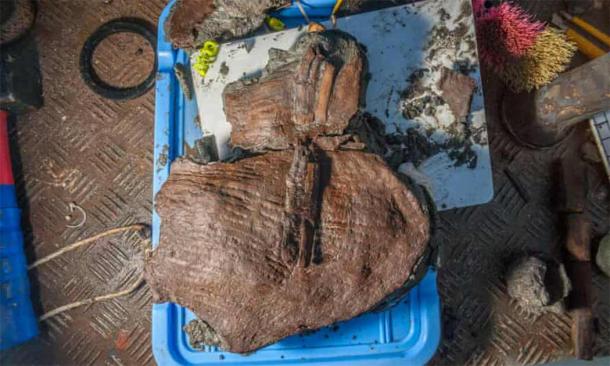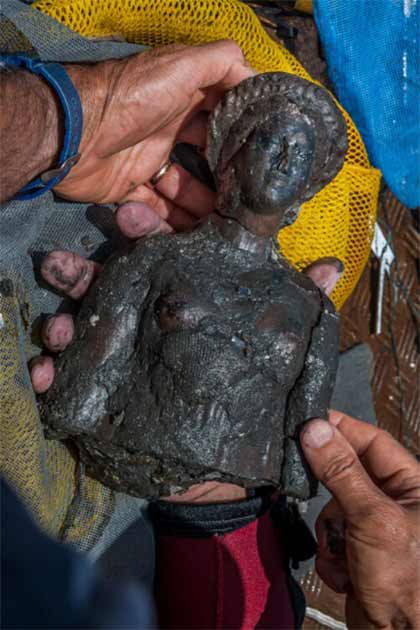Recently, while research work was underway at Thonis-Heracleion in the bay of Abu Qir, intact fruit baskets have been discovered that were dated to the 4th century BC!
The ancient Egyptian port city of Thonis-Heracleion is located 32 kms northeast of Alexandria, in the Mediterranean Sea. The once Greek city was founded as early as the 12th century BC and was Egypt’s primary port until it was superseded by Alexandria in the 2nd century BC.
“They have lain untouched underwater (for) 2,400 years, maybe because they were once placed within an underground room or were buried soon after being offered,” IEASM or the European Institute for Underwater Archaeology, led by French marine archaeologist Franck Goddio said.

A fragment of one of the fruit baskets brought to the surface by the French underwater archaeology team at Thonis-Heracleion. (Christoph Gerigk / Franck Goddio / Hilti Foundation )
Thonis-Heracleion: Wiped Out by Earthquakes and Tidal Waves
Wicker baskets filled with fruit including doum nuts (the fruit of an African palm tree considered sacred by the ancient Egyptians) and grape seeds, along with hundreds of ancient ceramic artifacts and bronze treasures have been discovered in the submerged ruins of Thonis-Heracleion, reports The Guardian .
The city would disappear under waves and water in the 2nd century BC, before sinking further in the 8th century AD following cataclysmic natural disasters, including an earthquake and tidal waves. In fact, several earthquakes followed by tidal waves led to a 42-square-mile (110-square-kilometer) portion of the Nile delta collapsing under the sea, taking with it the cities of Thonis-Heracleion and Canopus.
Thonis-Heracleion (a combination of the city’s Egyptian and Greek names) was for centuries Egypt’s largest port on the Mediterranean before Alexander the Great founded Alexandria in 331 BC, reports CNN Travel . Greeks were allowed to settle in the city during the late Pharaonic period (roughly between 660 BC and 330 BC) and built their own sanctuaries close to the massive temple of Amun.
The vast site in Aboukir Bay near Alexandria was forgotten until its re-discovery by the French marine archaeologist Franck Goddio two decades ago. The discovery is one of the most fascinating underwater archaeological finds in recent years.

We found hundreds of deposits made of ceramic. One above the other. These are imported ceramic, red on black figures, which are ancient Greek ceramics said underwater archaeologist Franck Goddio. (Christoph Gerigk / Franck Goddio / Hilti Foundation )
The Ancient Baskets May Have Been Used in Funerary Practices
Terming the finds “incredible”, Goddio added that “…Nothing was disturbed. It was very striking to see baskets of fruits.” There is an angle of religious ceremonies and ritual practices too – the baskets were stored in an underground room and may have been funerary practices , as per The Greek City Times . A tumulus-cum-burial mound, 197 x 26 feet (60 x 8 meters) was found nearby with an extravagant array of Greek funerary goods, most likely left by merchants and mercenaries who lived in the nearby area, as per IEASM.
“Everywhere we found evidence of burned material. Spectacular ceremonies must have taken place there. The place must have been sealed for hundreds of years as we have found no objects from later than the early fourth century BC, even though the city lived on for several hundred years after that. We found hundreds of deposits made of ceramic. One above the other. These are imported ceramic, red on black figures,” added Goddio.
Of the tumulus, Goddio waxes eloquently calling it “an island surrounded by channels.” In those channels, the researchers found large artifact deposits of bronzes, statuettes of Osiris, the Egyptian goddess of fertility , and distinctive red-and-black Greek ceramics that were likely imported. The bronze artifacts included hundreds of splendid mirrors and statuettes.

One of the many bronze statuettes found at the underwater Thonis-Heracleion site. (Christoph Gerigk / Franck Goddio / Hilti Foundation )
The Thonis-Heracleion Site Will Yield Much More Treasure!
What adds to the mystery and intrigue surrounding this particular site is its scale and unclear purpose of the ceremony. The evidence suggests a spectacular ceremony that was not repeated again.
People were possibly barred from re-entering the space ever again as none of the artifacts found there are dated to later than the early 4th century BC. Yet, the city has examples of being lived in for hundreds of years after this ceremony. Goddio estimates that only 3% of the sunken city has been discovered and re-discovered in the 20 years since it was found.
Additionally, the archaeologists also found a unique Ptolemaic galley ship , 82 feet (25 meters) in length, built in the classical tradition using mortise-and-tenon joints. The Ptolemaic ship also featured ancient Egyptian construction designs, like a flat base perfect for navigating the shallow Nile delta.
The team’s goal is to expand their knowledge of the ancient city by discovering many more hidden treasures and putting them all into chronological order and context.
Top image: Franck Goddio underwater at Thonis-Heracleion next to an ancient Egyptian stone statue. Source: Christoph Gerigk / Franck Goddio / Hilti Foundation
By Sahir Pandey
Related posts:
Views: 0
 RSS Feed
RSS Feed
















 August 10th, 2021
August 10th, 2021  Awake Goy
Awake Goy  Posted in
Posted in  Tags:
Tags: 
















